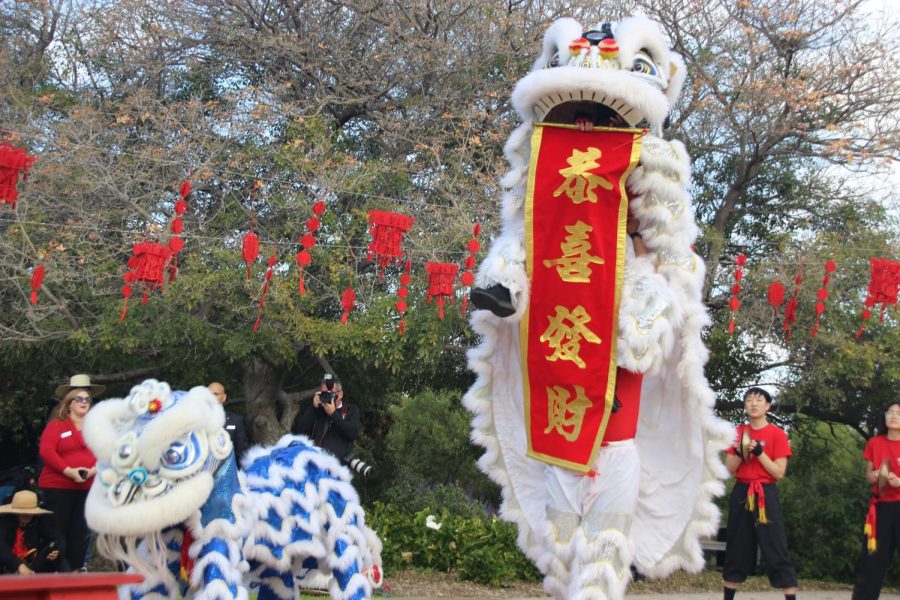Hopping Into Year of the Rabbit
Chinese Honor Society Performs at Local Lunar New Year Event
Fireworks, family and fortune—these are the major components of Asia’s biggest celebration. For many Asian countries, Jan. 22 marked the beginning of a new year, according to the lunar calendar. To celebrate, PVHS’s Chinese Honor Society collaborated with the South Coast Botanical Garden (SCBG) to hold its first-ever Lunar New Year celebration on Jan. 28. SCBG constructed a hedge backdrop of winter flowers and greenery, where New Year wishes were written and hung. SCBG also invited professional dancers from UCLA’s Association of Chinese Americans, Wushu Shaolin Entertainment, and Helen’s Dance Studio.
“This was the first time a new year event was held locally, so it was a big deal for our community,” PVHS Chinese teacher and event planner Nancy Wei said.
Out of the twelve rotating zodiac signs, the rabbit is 2023’s new zodiac animal.
“According to Chinese legend, the rabbit symbolizes peace, patience, longevity, and happiness,” Wei said.
Because the South Bay has a significant Asian population, Wei was surprised by the large proportion of non-Asian residents who attended the event.
“Several of my students told me they were impressed that so many different people came to learn about Asian culture,” Wei said. “I’m so happy that this event was a chance not only for Asian people to celebrate their heritage, but also for people from all different backgrounds to learn about our culture.”
The botanical garden’s celebration brought together a crowd of hundreds. Wei’s students performed on Chinese drums, danced with fans, and led event attendees in cheerful square dancing. Chinese Honor Society members also directed an array of interactive activities, from traditional Chinese calligraphy to fun chopstick competitions.
“I was teaching children to write the character chun, which means spring,” Chinese student and junior Cayden McGuire said. “This is an important character because it’s written on the spring scrolls that are used for decoration during Chinese New Year. It was fun for everyone to learn to write calligraphy and pronounce this character together.”
Although McGuire enjoyed teaching the community about Chinese culture, he shared that his favorite moment from the celebration was watching the professional dance groups perform.
“I didn’t realize how intricate the dances would be, especially the lion dance,” McGuire said. “I also got to see the costumes up close, and it was interesting to see all the details.”
Jun Bae, a martial artist, lion dancer and dragon dancer from Wushu Shaolin Entertainment, explains that the different-colored lions represent individual qualities, such as liveliness and courage. Bae describes the historical significance of the lion dance.
“The lion dance isn’t only used in celebrations, but also in different traditional ceremonies,” Bae said.
“The white lion is used for funerals. I’ve seen performances at funerals where they burn the lion, so the lion is a symbolic creature that transports the soul from this world to the next, according to Buddhist traditions. You can see that the lion dance involves a lot of movement, which represents the lion going through all these different places while a monk leads the way. It’s a lot deeper than what it seems to be.”
Throughout January, Bae and his dance team have been performing shows for schools, temples, city halls and more.
“Everybody is hoping for a lucky new year with a good heart and good intent,” Bae stated. “Lunar New Year celebrations really bring our focus back to the values of family, tradition, unity, peace and harmony.”
Wei highlights the benefits of understanding global traditions.
“It’s very important for people to learn about each other’s cultures, in order to understand each other better,” Wei said.
“A lot of times, conflicts occur just because of misunderstanding and miscommunication. This [Lunar New Year] event was not only a celebration, but also a bridge for different people to come together and to learn from one another.”
